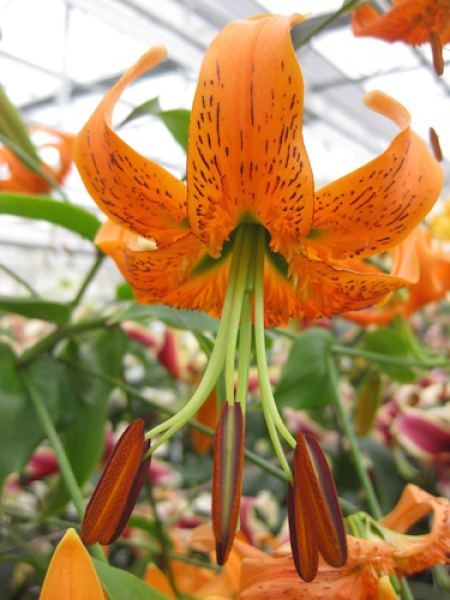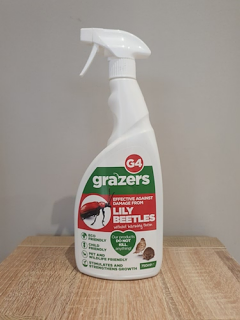- Gold Medal Winners
- Established 1945. Over 75 years experience
- 100% Customer Satisfaction
The Tiger Lily 'Henryi' originates from China and is also known as Henry's Lily after it was introduced to Europe by Augustine Henry.
This ornamental plant has small, downward-facing flowers with textured, recurving petals in a speckled orange/yellow colour. Henryi is also known as a Turk's Cap Lily due to its recurving petals. This variety of lily gets better year after year as it becomes more established. Henyri can reach up to 150cm tall and can often need some form of support for the abundance of blooms, potentially over 20 flowers per stem.
How to plant Lilies
- Lily Bulbs should be planted as soon as possible. Ideally in the Spring but can be planted up until the Autumn.
- Find a location with full sun or partial shade with well-drained soil.
- Lilies tend to grow exceptionally well in pots and tubs.
- Plant the bulbs with 4-6" of soil above them.
Planting Lilies in the Garden
- Find a location with full sun or partial shade with well-drained soil.
- Henryi Lilies are prefer an Alkaline soil.
- Arrange the Lilies in an odd-number grouping.
- Plant the bulbs about 12-20cm (5-8") apart.
- Space the groupings at least 60-90cm (2-3ft) apart.
- Plant the bulbs with 4-6" of soil above them.
Planting Lilies in Pots
- Find a location with full sun or partial shade with well-drained soil.
- Plant 3 bulbs in a 10-14" 'patio type' pot using good-quality, multi-purpose compost.
- John Innes No. 3 is ideal for lilies.
- Plant the bulbs with 4-6" of soil above them.
- These lilies are very sturdy but you may wish to give them some support in windy areas.
- Ensure there is adequate drainage.
Description
The Tiger Lily 'Henryi' originates from China and is also known as Henry's Lily after it was introduced to Europe by Augustine Henry.
This ornamental plant has small, downward-facing flowers with textured, recurving petals in a speckled orange/yellow colour. Henryi is also known as a Turk's Cap Lily due to its recurving petals. This variety of lily gets better year after year as it becomes more established. Henyri can reach up to 150cm tall and can often need some form of support for the abundance of blooms, potentially over 20 flowers per stem.
Additional Information
Delivery / Returns
Delivery and P&P
This item is dispatched all year around.
All orders should be dispatched within 3-5 working days.
Postage cost to the UK (excluding N.Ireland) is £5.50.
Orders over £50 qualify for FREE delivery.
Unfortunately, we are not currently delivering to the EU. See Delivery page.
When your order is due for dispatch, you will receive a tracking email from us to track your parcel.
Your parcel will be sent on a 24-48 hour tracked service with DPD.
Returns and Refunds
You have the right to cancel your order at any time before it is dispatched.
All returns must be returned at your cost within 7 days of receipt.
Payment for the returned goods will be refunded within 7 days of the goods being received by us, less the postage charges.
Planting & Growing Instructions
How to plant Lilies
- Lily Bulbs should be planted as soon as possible. Ideally in the Spring but can be planted up until the Autumn.
- Find a location with full sun or partial shade with well-drained soil.
- Lilies tend to grow exceptionally well in pots and tubs.
- Plant the bulbs with 4-6" of soil above them.
Planting Lilies in the Garden
- Find a location with full sun or partial shade with well-drained soil.
- Henryi Lilies are prefer an Alkaline soil.
- Arrange the Lilies in an odd-number grouping.
- Plant the bulbs about 12-20cm (5-8") apart.
- Space the groupings at least 60-90cm (2-3ft) apart.
- Plant the bulbs with 4-6" of soil above them.
Planting Lilies in Pots
- Find a location with full sun or partial shade with well-drained soil.
- Plant 3 bulbs in a 10-14" 'patio type' pot using good-quality, multi-purpose compost.
- John Innes No. 3 is ideal for lilies.
- Plant the bulbs with 4-6" of soil above them.
- These lilies are very sturdy but you may wish to give them some support in windy areas.
- Ensure there is adequate drainage.
Care Instructions
How to care for Henryi Lilies
- Lilies can tolerate very cold conditions but they do not like to get wet.
- If planting in borders in the garden, the soil must be well drained and, preferably, humus rich.
- If planting in pots, make sure lilies are kept moist but do not get waterlogged.
- Lilies prefer to be planted in a location with at least half a days full sunshine, if its a bit too shady they will lean their stems towards the sun.
- Lily bulbs do not like to be dried out so they must be kept in soil at all times.
- Try to plant your lilies where they will dry out after rain to prevent Botrytis, a fungus that spots the leaves. If you do see brown spots on your leaves, spray with a fungicide recommended for roses.
- If planting in pots, it may be an idea to tilt the pots on their side in the winter to prevent waterlog.
- When the Lily has finished flowering, cut any seed heads back and allow the foliage to die back naturally. Do not be tempted to cut the stem back until stems becomes hollow and brown.
- Lilies like a cold dormant phase and are happy to stay outside throughout the winter, just ensure they don't get waterlogged as this will cause the to rot.
- After a few years of flowering, you may find the Lilium Henryi produces less blooms, it may be time to lift your bulbs and divide them by breaking off the bulblets. All the bulbs will then need replanting.
- To prevent Lily Beetles from damaging your lilies, we recommend using the Lily Beetle Prevention Spray or making up your own and using the Concentrate. This Spray (Grazers G4) will also stimulate growth of your lilies.
- You can feed your lilies with a Tomato Feed to stimulate and strengthen your lilies when you start to see signs of growth. Make up your tomato feed with half the recommended dilution (written on the instructions on the bottle) and feed once every 3 weeks.
-
Description
The Tiger Lily 'Henryi' originates from China and is also known as Henry's Lily after it was introduced to Europe by Augustine Henry.
This ornamental plant has small, downward-facing flowers with textured, recurving petals in a speckled orange/yellow colour. Henryi is also known as a Turk's Cap Lily due to its recurving petals. This variety of lily gets better year after year as it becomes more established. Henyri can reach up to 150cm tall and can often need some form of support for the abundance of blooms, potentially over 20 flowers per stem.
- Additional Information
- Reviews (0)
- Delivery / Returns
- Planting & Growing Instructions
How to plant Lilies
- Lily Bulbs should be planted as soon as possible. Ideally in the Spring but can be planted up until the Autumn.
- Find a location with full sun or partial shade with well-drained soil.
- Lilies tend to grow exceptionally well in pots and tubs.
- Plant the bulbs with 4-6" of soil above them.
Planting Lilies in the Garden
- Find a location with full sun or partial shade with well-drained soil.
- Henryi Lilies are prefer an Alkaline soil.
- Arrange the Lilies in an odd-number grouping.
- Plant the bulbs about 12-20cm (5-8") apart.
- Space the groupings at least 60-90cm (2-3ft) apart.
- Plant the bulbs with 4-6" of soil above them.
Planting Lilies in Pots
- Find a location with full sun or partial shade with well-drained soil.
- Plant 3 bulbs in a 10-14" 'patio type' pot using good-quality, multi-purpose compost.
- John Innes No. 3 is ideal for lilies.
- Plant the bulbs with 4-6" of soil above them.
- These lilies are very sturdy but you may wish to give them some support in windy areas.
- Ensure there is adequate drainage.
- Care Instructions
- Ask the Experts
- FAQs
















